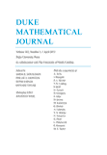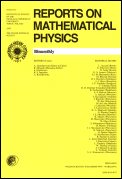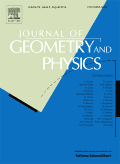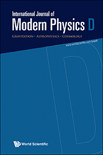
LETTERS IN MATHEMATICAL PHYSICS
Scope & Guideline
Fostering multidisciplinary dialogue for groundbreaking discoveries.
Introduction
Aims and Scopes
- Mathematical Foundations of Physics:
The journal focuses on the rigorous mathematical underpinnings of physical theories, exploring structures and frameworks that support quantum mechanics, general relativity, and statistical mechanics. - Quantum Field Theory and Quantum Mechanics:
A significant portion of the research covers advanced topics in quantum field theory, including quantization methods, quantum entropy, and the interplay between quantum states and geometry. - Integrable Systems and Solitons:
Publications frequently delve into integrable systems, solitons, and their mathematical descriptions, providing insights into their applications in both classical and quantum contexts. - Geometric and Algebraic Methods:
The journal emphasizes the use of geometric and algebraic techniques, such as algebraic structures related to quantum groups, symplectic geometry, and the geometry of spacetime. - Statistical Mechanics and Thermodynamics:
Research in the journal includes studies on statistical mechanics, phase transitions, and thermodynamic properties of quantum and classical systems. - Applications of Mathematical Physics:
The journal also explores practical applications of mathematical physics in fields like condensed matter physics, cosmology, and mathematical biology.
Trending and Emerging
- Quantum Information and Computation:
Recent publications emphasize quantum information theory, including quantum entropies, quantum memory, and applications in quantum computing, reflecting the growing importance of these topics in modern physics. - Geometric Quantum Field Theory:
There is an increasing focus on the geometric aspects of quantum field theory, particularly in relation to topological features and their implications for physical theories. - Mathematical Aspects of Quantum Gravity:
Research pertaining to quantum gravity, including the mathematical formulations and implications of spacetime geometry, has gained traction, indicating a shift towards unifying quantum mechanics with general relativity. - Algebraic Structures in Physics:
The journal has seen a rise in articles exploring algebraic structures, such as vertex operator algebras and quantum groups, which are becoming central to understanding symmetries and dualities in physics. - Nonlinear Dynamics and Integrability:
There is a notable increase in studies addressing nonlinear dynamics, integrable systems, and soliton theory, highlighting their relevance in both theoretical and applied contexts.
Declining or Waning
- Classical Mechanics and Non-relativistic Physics:
There has been a noticeable decrease in publications related to classical mechanics, particularly in areas that do not intersect with modern quantum theories or advanced mathematical formulations. - Low-dimensional Topological Field Theories:
Research on low-dimensional topological field theories appears to have diminished, as the journal's focus shifts more towards higher-dimensional theories and their applications. - Elementary Particle Physics:
The journal has seen fewer contributions focused solely on elementary particle physics, possibly due to the increasing complexity and specialization required in this field. - Non-standard Quantum Theories:
Topics related to non-standard or alternative quantum theories seem to be less represented, indicating a possible consolidation around more established theories and models. - Classical Statistical Mechanics:
There is a decline in articles centered on classical statistical mechanics, particularly those without direct connections to quantum phenomena or modern computational methods.
Similar Journals

Physics, published by MDPI, is an open-access journal that commenced in 2019 and has quickly established itself as a significant contributor to the field of physics and astronomy. With a respectable impact factor and categorized in the Q2 quartile for 2023, this journal serves a broad spectrum of topics within the discipline, fostering innovative research and insights. As part of the MDPI portfolio, known for promoting high-quality, peer-reviewed research, Physics aims to provide a platform for scholars, professionals, and students to publish their findings and engage with contemporary debates in the field. The journal's accessibility, paired with its commitment to scientific excellence, ensures that research is readily available to a global audience, which is crucial for advancing knowledge and collaboration in physics. Located in the heart of Switzerland at ST ALBAN-ANLAGE 66, CH-4052 BASEL, the journal enjoys a position at the nexus of cutting-edge research and academia.

THEORETICAL AND MATHEMATICAL PHYSICS
Exploring the Depths of Mathematical InnovationTHEORETICAL AND MATHEMATICAL PHYSICS, published by MAIK NAUKA/INTERPERIODICA/SPRINGER, is a premier journal dedicated to advancing the fields of Mathematical Physics and Statistical and Nonlinear Physics. With an impressive history spanning from 1969 to 2024, this journal serves as a vital platform for researchers, professionals, and students eager to explore cutting-edge theoretical frameworks and mathematical models. Although it currently holds a Q3 ranking in both its categories as per the 2023 metrics and is positioned within the Scopus ranks reflecting its growing influence, the journal continually aims to enhance its impact within the academic community. The publication does not currently provide open-access options, underscoring its collector’s nature in the dissemination of valuable research findings. Submissions are welcomed from diverse areas of theoretical physics, providing a rich and collaborative environment for the exploration of complex phenomena and the development of innovative methodologies.

DUKE MATHEMATICAL JOURNAL
Pioneering Research in the Heart of MathematicsDUKE MATHEMATICAL JOURNAL, published by DUKE UNIVERSITY PRESS, stands as a premier journal in the field of Mathematics, with an esteemed reputation reflected in its Q1 ranking in Mathematics (miscellaneous) for 2023 and its status as one of the top 50 journals in General Mathematics according to Scopus rankings. Since its inception in 1935, this journal has committed to publishing high-quality research that pushes the boundaries of mathematical knowledge and theory. With a broad scope that encompasses various areas within mathematics, the journal serves as a vital platform for disseminating innovative ideas and findings. Although it does not offer Open Access options, its rigorous peer-review process ensures the integrity and excellence of the work it publishes, making it an essential resource for researchers, professionals, and graduate students aiming to contribute to or stay informed about the rapid advancements in this dynamic field. For more information, visit its office at 905 W MAIN ST, STE 18-B, DURHAM, NC 27701.

COMMUNICATIONS IN MATHEMATICAL PHYSICS
Advancing the Frontiers of Mathematical PhysicsCOMMUNICATIONS IN MATHEMATICAL PHYSICS is a premier journal in the realm of mathematical physics, published by Springer and recognized for its rigorous scholarship and comprehensive coverage of the field since its inception in 1965. With an impressive impact factor reflecting its influential contributions—ranking Q1 in both Mathematical Physics and Statistical and Nonlinear Physics—the journal consistently attracts high-quality submissions. It holds notable standings in Scopus, ranked 11th in Mathematical Physics and 12th in Statistical and Nonlinear Physics, marking it as a critical venue for both emerging and established researchers. The journal is dedicated to the dissemination of groundbreaking research and reviews, thereby fostering dialogue and innovation in a constantly evolving discipline. It provides invaluable access to cutting-edge theoretical advancements, making it an essential resource for professionals and students alike engaged in this dynamic field of study.

Annals of Physics
Advancing the frontiers of Physics and Astronomy.Annals of Physics is a premier journal published by Academic Press Inc Elsevier Science, specializing in the expansive field of Physics and Astronomy. Since its inception in 1957, this journal has played a pivotal role in disseminating high-quality research and advancements across various sub-disciplines of physics. With a notable impact factor making it rank in the Q1 category for 2023, it stands among the top tier of scholarly publications, specifically sitting at Rank #63 out of 243 in the field, placing it in the 74th percentile according to Scopus metrics. Researchers are encouraged to submit their findings to reach a broad audience without the constraints of Open Access fees, promoting extensive visibility within the academic community. As we look ahead to 2024, Annals of Physics continues to be an essential resource for professionals, students, and academics striving to advance the frontiers of knowledge in physics and astronomy.

REPORTS ON MATHEMATICAL PHYSICS
Illuminating the Foundations of Physical PhenomenaREPORTS ON MATHEMATICAL PHYSICS is a distinguished journal published by PERGAMON-ELSEVIER SCIENCE LTD, focusing on the intricate interplay between mathematics and physics. Established in the United Kingdom, this journal has been contributing to the academic community since its inception, publishing significant research findings that explore the theoretical underpinnings of physical phenomena. With an ISSN of 0034-4877 and an E-ISSN of 1879-0674, the journal maintains a consistent publishing history, converging research from 1970 to 2024. It is currently ranked Q3 in both Mathematical Physics and Statistical and Nonlinear Physics categories, reflecting its commitment to maintaining a high standard of scholarly work. Although it lacks Open Access options, its targeted audience of researchers, professionals, and students will find invaluable insights into advanced mathematical methods, statistical applications, and innovative approaches in physics. With its esteemed reputation and critical role in the field, REPORTS ON MATHEMATICAL PHYSICS continues to be an essential resource for those seeking to deepen their understanding of mathematical applications in physical systems.

Symmetry Integrability and Geometry-Methods and Applications
Pioneering Research in Symmetry and GeometrySymmetry Integrability and Geometry-Methods and Applications is a prominent open-access journal published by the NATIONAL ACADEMY OF SCIENCES OF UKRAINE, INSTITUTE OF MATHEMATICS, dedicated to advancing research in the fields of Analysis, Geometry and Topology, and Mathematical Physics. Since its inception in 2005, the journal has provided an esteemed platform for scholars from around the globe to share their innovative findings and methodologies, contributing to our understanding of complex mathematical concepts. With an impressive Q2 ranking in all three mathematical categories as per the 2023 Scopus rankings, the journal positions itself as a key resource for researchers seeking high-quality, peer-reviewed content. As a fully open-access publication, it ensures that research is readily available to a wide audience, fostering collaboration and knowledge exchange in the mathematical sciences.

JOURNAL OF GEOMETRY AND PHYSICS
Exploring the Nexus of Geometry and PhysicsThe JOURNAL OF GEOMETRY AND PHYSICS is a distinguished peer-reviewed journal published by Elsevier, dedicated to fostering the exploration and dissemination of research at the intersection of geometry and physics. Established in 1984, this journal covers a broad range of topics, including the theoretical aspects of geometry, topology, and mathematical physics, making it an essential resource for researchers and practitioners in these fields. With an impressive Q2 ranking in various categories, including Geometry and Topology, Mathematical Physics, and General Physics and Astronomy, the journal ranks among the top 25% of its peers, reflecting its significant impact in advancing relevant discourse. Although currently not offered as an open-access publication, it maintains a strong readership due to its contribution to high-quality scholarly articles and critical reviews. The journal’s commitment to stimulating innovative research continues to solidify its reputation as a pivotal platform for exchanging ideas and fostering collaboration within the scientific community.

Turkish Journal of Physics
Elevating academic discourse in physics and beyond.Turkish Journal of Physics, established in 1994 and published by the Tubitak Scientific & Technological Research Council Turkey, is a prominent platform for the dissemination of innovative research in the field of physics and related areas. With an ISSN of 1300-0101 and an E-ISSN of 1303-6122, this journal has carved a niche in the academic community, evidenced by its ranking within the Q3 category in the 2023 evaluation of Physics and Astronomy. As it converges its published works toward the year 2024, researchers and scholars are encouraged to engage with its rich repertoire of studies that covers general physics and astronomy, currently holding a Scopus rank of #96 out of 243, placing it in the top 60th percentile. The Turkish Journal of Physics serves as a vital resource for advancing knowledge, fostering collaborative research, and providing insights into contemporary advancements in the discipline. While it operates under a subscription model, the quality and impact of its peer-reviewed articles make it an essential read for professionals and students alike, looking to stay informed on critical developments within the physics community.

INTERNATIONAL JOURNAL OF MODERN PHYSICS D
Exploring the Cosmos through Rigorous ResearchWelcome to the INTERNATIONAL JOURNAL OF MODERN PHYSICS D, a premier publication dedicated to the advancement of knowledge in the fields of Astronomy and Astrophysics, Mathematical Physics, and Space and Planetary Science. Published by WORLD SCIENTIFIC PUBL CO PTE LTD in Singapore, the journal boasts an impressive impact, being ranked Q2 in Astronomy and Astrophysics and Mathematical Physics, and Q3 in Space and Planetary Science. With a converged publishing timeline from 1996 to 2024, this journal provides a vital platform for researchers and professionals to disseminate their findings, engage with cutting-edge research, and explore emerging ideas in modern physics. Although it operates under a traditional access model, the rigorous peer-reviewed process ensures that only the highest quality research contributes to the collective understanding of our universe. Join us in advancing the frontiers of physics and astronomy!